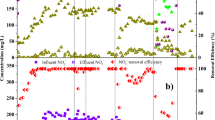Abstract
Currently available microbiological techniques are not designed to deal with very slowly growing microorganisms. The enrichment and study of such organisms demands a novel experimental approach. In the present investigation, the sequencing batch reactor (SBR) was applied and optimized for the enrichment and quantitative study of a very slowly growing microbial community which oxidizes ammonium anaerobically. The SBR was shown to be a powerful experimental set-up with the following strong points: (1) efficient biomass retention, (2) a homogeneous distribution of substrates, products and biomass aggregates over the reactor, (3) reliable operation for more than 1 year, and (4) stable conditions under substrate-limiting conditions. Together, these points made possible for the first time the determination of several important physiological parameters such as the biomass yield (0.066 ± 0.01 C-mol/mol ammonium), the maximum specific ammonium consumption rate (45 ± 5 nmol/mg protein/min) and the maximum specific growth rate (0.0027 · h−1, doubling time 11 days). In addition, the persisting stable and strongly selective conditions of the SBR led to a high degree of enrichment (74% of the desired microorganism). This study has demonstrated that the SBR is a powerful tool compared to other techniques used in the past. We suggest that the SBR could be used for the enrichment and quantitative study of a large number of slowly growing microorganisms that are currently out of reach for microbiological research.
Similar content being viewed by others
Explore related subjects
Discover the latest articles and news from researchers in related subjects, suggested using machine learning.Author information
Authors and Affiliations
Additional information
Received: 14 May 1998 / Received last revision: 30 July 1998 / Accepted: 31 July 1998
Rights and permissions
About this article
Cite this article
Strous, M., Heijnen, J., Kuenen, J. et al. The sequencing batch reactor as a powerful tool for the study of slowly growing anaerobic ammonium-oxidizing microorganisms. Appl Microbiol Biotechnol 50, 589–596 (1998). https://doi.org/10.1007/s002530051340
Issue Date:
DOI: https://doi.org/10.1007/s002530051340




